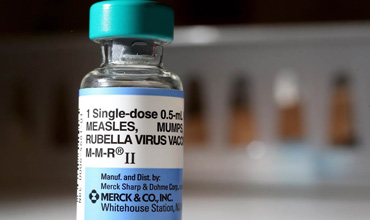Prevalence of Drop out and associated factors in Measles immunization among children in Kanyakumari District, Tamilnadu, India.

Abstract:
Introduction: Measles is the main cause of childhood
morbidity and mortality and highly prevalent worldwide. Over the last 15 years
there has been a general decline in all the reported Vaccine Preventable
Diseases in India but the decline in measles incidence is far below the
expected level. WHO targets measles next to polio for eradication.
Objectives: 1) To determine the immunization
coverage in measles in Kanyakumari district and 2) To identify the factors
associated with Drop outs.
Methodology: This is a community based cross
sectional study conducted in whole Kanyakumari district in Tamilnadu, India
from June 2012 to May 2013 with 210 children in the age group between 12 and 23
completed months selected by 30 x 7 cluster sampling method. Structured pre
tested Questionnaire was used to collect data.
Results: Mean age of the children was 18.1 ± 3.1 (SD) months.
Out of 210 children, 171 children
(81.4%) were immunized for measles vaccination. 64.9%
vaccinated in Government facility and
35.1% of children in private setup. Forgetfulness due to longer timegap
between OPV/DPT 3rd Dose and Measles vaccine was the most common
factor for drop out constituting 25.6%. Area of
Residence, Marital Status of the parents, Total Income, Distance and the
Availability of Immunisation card are the significantly associated with
Dropouts.
Conclusion: The prevalence of dropout is 18.6%. Forgetfulness,
Area of residence, Marital status and Income of parents, Distance, Availability
of immunization card were the significant factors associated with Drop outs.
References:
[1.] Abhishek Kumar, S.K. Mohanty. (2009). Understanding the
Factors Associated with slow Progress in Childhood Immunisation in India. Paper
Submitted in XXVI IUSSP International Population Conference in Marrakech,
Morocco. 2009.
[2.] Akhalesh Kumar Shakya, Vibha Shukla, Harjeet Singh
Maan, Tapan N Dhole. (2012). Identification of different lineages of measles
virus strains circulating in Uttar Pradesh, No rth India. Virology Journal,
9:237 DOI:10.1186/1743-422X-9-237.
[3.] Bhagyalaxmi A, Kedia G, Rawal VS. (2007). Study of
incidence of measles and vaccination coverage in Ahmedabad urban slums. Indian
J Public Health 2007;51(1):52-53.
[4.] DLHS 2007-08. District Level household and Facility
Survey 2007-08. Fact Sheets India. Ministry of Health and Damily Welfare,
Nirman Bhavan, New Delhi 110011.
[5.] Freeman PA, Thomason JA, Bukenya GB, (1992). Factors
affecting the use of immunization among urban settlement dwellers in Papua New
Guinea. PNG Med J. 1992 Sep; 35(3) : 179-85.
[6.] Gregory A. Poland, Robert M Jacobson. (2012). The
Re-Emergence of Measles in Developed Countries: Time to Develop the Next-Generation
Measles Vaccines? Vaccine Jan 5, 2012; 30(2): 103–104.
[7.] Hussen Mohammed, Alemayehu Atomsa. (2013). Assessment
of Child Immunization Coverage and Associated Factors in Oromia Regional State,
Eastern Ethiopia. Science, Technology and Arts Research Journal .Jan-Mar
2013,2(1): 36-41.
[8.] Kishore J. (2011). Reproductive and Child Health
Program –II. In: J. Kishore (Editor), National Health Programs of India, 9th
Edition. Century Publishers, New Delhi, 2011: 155-160.
[9.] National Rural health Mission 2014. Disease Alerts
/Outbreaks Reported and Responded to by the States / UTs through IDSP 22nd week
2014. Ministry of Health and Family Welfare, Nirman Bhavan, New Delhi -110011.
Available at: http://www.idsp.nic.in/idsp/IDSP/rcntobrk.pdf Accessed on 02 June
2014.
[10.] Niyi Awofeso, Anu Rammohan, Kazi Iqbal. (2013).
Age-appropriate vaccination against measles and DPT-3 in India – closing the
gaps. BMC Public Health, 13:358
DOI:10.1186/1471-2458-13-358.
[11.] Owino LO, Irimu G, Olenja J, Meme JS. (2009). Factors
influencing immunization coverage in Mathare Valley, Nairobi, East Afr Med J.
2009 Jul; 86(7) 322-9.
[12.] Pushpa Narayan. (2011). TN moms to get cash for
vaccines. The Times of India (Chennai Edition), Aug 1, 2011. Availabel at http://timesofindia.indiatimes.com/city/chennai/TN-moms-to-get-cash-for-vaccines/articleshow/9438314.cms
Accessed on 20 Feb 2014.
[13.] Rajesh Vaidhya. (2009). Measles. In: RajVir Bhalwar,
Chief Editor, Text Book of Public Health and Community Medicine, First Edition,
New Delhi, AFMC, 2009: 1089-92.
[14.] Rup Kumar Phukan, Manash Pratim Barman, Jagadish
Mahanta. (2009). Factors Associated with Immunization coverage of children in
Assam, India : Over the first year of life. Journal of Tropical Pediatrics.
Volume, 55, Issue 4 : Pp. 249 – 252.
[15.] Singh P, Yadav R.J. (2000). Immunization status of
children of India. Indian Pediatrics; 37: 1194–1199.
[16.] Surender N Gupta, Naveen Gupta. (2009). Two highly
immunized hilly areas versus double measles outbreak investigations in district
Kangra, Himachal Pradesh, India, in 2006. Public Health Research; 1(1): 14-20.
[17.] UNICEF - Coverage Evaluation Survey 2009: National
Fact Sheet. Ministry of Health and Family Welfare, Nirman Bhavan, New Delhi –
110011.
[18.] VK Desai, SJ Kapadia, Pradeep Kumar, Siddharth
Nirupam. (2003). Study of Measles Incidence and Vaccination Coverage in Slums
of Surat City. Indian Journal of Community Medicine Vol. XXVIII, No.1,
Jan.-Mar., 2003. 10-14.
[19.] World Health Organization. (2014). Fact Sheet –
Measles, Fact sheet N°286, Updated February 2014. Available at: http://who.int/mediacentre
/factsheets/fs286/en/ accessed on 23 March 2015.

